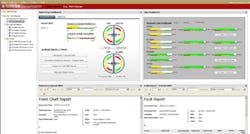Modern manufacturing is plagued by islands of systems and silos of data. Operating in that environment creates real costs in blocked efficiency, incomplete decision making, in waste, in recalls, in lost customer loyalty, in delayed product launches. With federated tools from Rockwell Automation, manufacturers can make the information in those silos visible and avoid the pitfalls of manual data collection and reporting. A unified production model transforms that stew of data into reliable Manufacturing Intelligence that can drive operational improvements swiftly and efficiently based on the user’s role within the plant.
Key Performance Indicators (KPIs), such as downtime, throughput and labor cost, have long been yardsticks for manufacturers to monitor their progress toward an operational goal, but they present some key challenges:
• Is the information accurate and current?
• How does it fit into the bigger picture of what’s causing me problems in my plant?
• How do I get information out of the system and actually use it?
Automated data collection has all but overcome the challenges of accuracy, timeliness (and thus cost) posed by manual means of logging KPIs like downtime. FactoryTalk Metrics from Rockwell Automation records machine downtime events whether or not that downtime is visible to the operator’s naked eye, and whether or not it causes a downstream bottleneck. But knowing that a downtime event occurred is only part of the story. With time-stamped process information from FactoryTalk Historian, a manufacturer can identify individual process variables as temperature, pressure, or speed, or compare current production variables with the parameters of a sweet-spot in the product’s process history.
Both capabilities are vital to manufacturing visibility. But gaining the ability to find the connection between a machine event and a process variable, in time to do something about it, is the golden goose in operational effectiveness.
For example, a packager entered into a purchase agreement with an OEM that specified that the equipment must run at 90 percent efficiency. When data collection began on the machine, it was clear it was not performing at that level. No matter what adjustments the manufacturer made, it encountered the same efficiency gap. The manufacturer noted that every time the line speed went up, the machine shut off to give one of the heaters time to cycle back up to temperature again. Correlating process data with event data, the manufacturer was able to prove that the heater was undersized—a design flaw the OEM had to amend that would have otherwise consistently given bad results.
That correlation was achieved with FactoryTalk VantagePoint. VantagePoint gathers multiple datasets, places them in their appropriate context, and provides role-based reporting that enables action. It allows users to create KPIs that are driven all the way through a business—from a line to multiple plants—to determine whether or not they are running effectively.
“The idea is simple,” says Matt Giordano, Product Manager, Rockwell Automation. “If the problem is downtime, a user shouldn’t have to search high and low for which reports will get to the root cause of the problem. The information—whether from a controller or Historian, a LIMs or a Quality system—should already be correlated into a report that provides clear and accurate information relevant to solving the problem.”
What’s more, VantagePoint provides users visualization tools based on downtime or other relevant KPIs so that, when one begins to go awry, a user can drill down into it button-by-button and take corrective action while it is still cost-effective to do so.
An operator, for example, may be viewing Overall Equipment Effectiveness (OEE) on a machine-level dashboard embedded into an HMI screen that alerts him to when process variables reach their upper or lower limits. A line supervisor might see that OEE is running lower than it should be, and can drill down into detailed reports on line speed or percentage quality. A plant manager might start with a simple display with three indicators—red, yellow, green—to tell whether or not the plant is producing what it should be producing. An executive may want to tie output into financial information that comes from the ERP, drilling into factors like the cost of scrap, or capacity, actual production and the difference in lost sales.
“Manufacturing Intelligence is moving operations toward integration: factories with their supply chains, distribution systems, customer relationships and business systems,” says Giordano. “The coordination of all these systems allows us to slice and dice, twist and spin information and use it ways that never imagined we’d be able to. It’s that unprecedented view of operations that enables us to achieve maximum effectiveness in the manufacturing enterprise.”
For more information, visit Manufacturing Intelligence.

